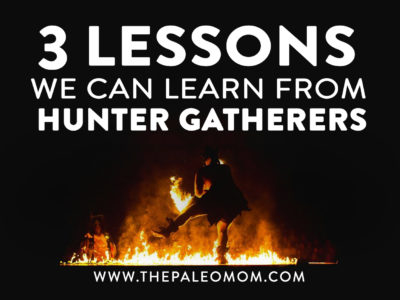The Paleo diet isn’t about historical reenactment. Instead, understanding what our Paleolithic ancestors ate, and how they lived, is a starting point for understanding what shaped our biological needs and how to best nourish our bodies now. While the basis for my recommendations will continue to be insight from modern biological, medical and nutritional sciences research, I still believe there’s much to learn from our hunter-gatherer ancestors — and their modern counterparts.
Table of Contents[Hide][Show]
1. Sleep when the sun sleeps
Without caffeine, electronics, climate-controlled interiors, pharmaceuticals, artificial light, late-night TV, and other features of modern society that help us override our body’s natural signals, hunter-gatherers tend to go “to bed” within a couple of hours of sunset and wake up just before sunrise (see How Much Sleep Do We Need).
Sleeping when the sun “sleeps” allows for healthy circadian rhythms. The term “circadian rhythm” refers to the fact that a huge array of biological processes within the human body cycle according to a 24-hour clock. One of the best ways to set your circadian clock is be exposed to bright light (ideally sunlight) during the day, but be in the dark at night, just as hunter-gatherer populations would be (see The New Science of Sleep and Wake Cycles). If you can’t align your sleep patterns with the sun because of your work schedule or other lifestyle factors you can’t give up, try to spend time out in the sun or use a light therapy box during the day (or “your day” if you’re a shift worker). And wear amber-tinted glasses once the sun goes down (or a few hours before you go to bed if you’re a shift worker). You might also try installing blackout curtains and using them while you sleep. When your circadian rhythms are properly regulated, you sleep well, you have energy in the mornings, and your energy is constant throughout the day until it starts to gradually diminish in the evening (also check out Go To Bed, the ultimate resource for improving your sleep!).
2. Don’t go low carb (or low fat!)
Analysis of hunter-gatherer societies across the world suggests they average about half of their diet (calorie-wise) from animal foods and about half from plant foods, with wiggle room on either side depending on what types of meat and vegetation are abundant! Keep in mind that 50% of dietary calories from one type of food isn’t the same as 50% dietaryvolume from that food, meaning that if you aim for a diet of approximately 50% plants and 50% animals, as hunter-gatherers tend towards on average, the plants will take up more visual space in each meal, typically on the order of plant foods taking up 2/3 to 3/4 of your plate (see The Diet We Were Meant to Eat Part 3). A diet in which 50% of calories are coming from plant foods, will tend to include some carbohydrates. In other words, the diets of hunter-gatherers generally are not low carb (see Carbs Vs. Protein Vs. Fat: Insight from Hunter-Gatherers).
The bulk of the available scientific evidence also points to low-fat diets also having plenty of risks! For one, we need some dietary fat to optimize the absorption of the fat-soluble vitamins A, D, E, and K. Also, low-fat diets and having low levels of serum cholesterol (which tend to go hand-in-hand) have been linked to a variety of health conditions, including depression and suicide (low-fat diets may impair serotonin receptors by decreasing the fats in nerve-cell membranes), anxiety, aggression, other violent behavior, premature death, and even cancer (fat and cholesterol are important for the integrity of cell membranes). And hunter-gatherers certainly don’t follow low fat diets. Most contemporarily-studied hunter-gatherers get as much as 58% of their calories from fat. Overall, the research points towards a moderate fat intake (30-40% of calories, perhaps as high as 50% for some people) being ideal for maintaining all aspects of our health (see Saturated Fat: Healthful, Harmful or Somewhere in Between).
3. Move throughout the day
Hunter-gatherers, including both men and women, participate in regular movement to keep their societies running smoothly. Men are often in charge of hunting large game, trekking long distances and mixing periods of rest with spikes of brief, intense exertion. Women are often in charge of foraging for edible plants and small animals or eggs—with periods of rest interspersed with hours of walking, digging, stretching, and bending in order to collect food and bring it back to camp.
However, hunter-gatherers don’t expend much more energy than we do in Western societies today. The difference is that, instead of hitting the gym before work and then sitting on a chair for the next eight hours, they engage in frequent, lower intensity activity that occurs pretty much from the time they get up to the time they go to sleep, with less frequent bouts of intense movement. Hunter-gatherers spend very little time being totally sedentary (a risk factor for disease, see The Benefits of Gentle Movement), and most of their movement is light to moderate rather than vigorous.
Adding more movement throughout your day can be as a simple as taking 2 minutes to walk around and stretch out of every 20 minutes you’re sitting at work or watching TV. Or, you might want to invest in a DeskCycle to get even more movement while you work. More rigorous activity like working out at the gym is still beneficial, but the key is to break up sedentary time with regular movement all day long.
Though hunter-gatherers shouldn’t necessarily be a model for every aspect of our modern lifestyle, traditional cultures offer many best-practices we can use to improve our lives. Keep these three lessons in mind as you pursue your health goals!









